- About us
- Support the Gallery
- Venue hire
- Publications
- Research library
- Organisation chart
- Employment
- Contact us
- Make a booking
- Onsite programs
- Online programs
- School visit information
- Learning resources
- Little Darlings
- Professional learning
When Jenny Sages chooses to paint a portrait it is usually for the Archibald Prize and only when a subject is especially interesting to her personally. Her portrait of writer Kate Grenville AO (b. 1950) was her 2014 Archibald entry. 'When I met Jenny Sages,' Grenville says, 'I realised we were on the same wavelength as creators.' She and Sages had a number of sittings in Sydney during which Sages made sketches and took photographs. Seeking an apposite landscape setting, they then travelled to the Hawkesbury River, the location for Grenville’s award-winning novel The Secret River (2005), based on the life of her convict three-times great-grandfather, and its sequel Sarah Thornhill (2011). 'When we found that spot by the river, and the little jetty, we both knew straight away that that was it. I took off my shoes, because I very much wanted to have that feeling of being barefoot on the land … And she drew me, and photographed me, and then went away and produced this wonderful portrait.'
Gift of the artist 2014. Donated through the Australian Government's Cultural Gifts Program.
© Jenny Sages
A portrait of the writer Kate Grenville by Jenny Sages created in 2012. Encaustic, oil and pigment on composition board measuring 180 centimetres in height and 190 centimetres in length.
The surface of the work is hardened wax that has been scratched and gouged with sharp tools. The figure and background are delicately coloured with powdered pigments and minimal use of oil paint. Brush marks, smudges of rubbed-in pigment and marks in the wax are evident, building up areas of texture. Kate is barefoot, seated on a small jetty by the Hawkesbury River. It’s the setting for her trilogy of colonial novels and where her convict great-great-great grandfather took up land after being pardoned following transportation to Australia in 1806.
A black line is drawn horizontally at the top of the work marking out a river shoreline. Contained in a narrow band above this line are mountain ranges outlined in green pigment, appearing hazy and light in the distance. In front of the mountains, darker green trees line the shore. They are smudged, edges bleeding into each other. Below this shoreline is a calm river coloured in light-blue pigment which transitions to white in the middle to create a halo effect around Kate’s head and upper torso. In the the lower half of the work colours graduate from light to dark, mustard yellow, rusty orange and dark brown reeds and grasses grow on either side of the jetty. They lean towards the water and hug the bottom left corner. The surface of the wax in this area is heavily textured with stipple marks and lines scratched into the surface. The jetty is positioned in the centre, cropped by the lower edge of the board.
A mass of vibrant red and russet-brown curls spiral and crackle on top of Kate’s head. The spiral curls are longer at the top and cropped short around her ears. She gazes outwards with bright blue eyes, lined with gentle wrinkles. Her eyes are framed by rectangular glasses that are the same colour as her hair. Her pale skin has a warm glow, and her mouth is closed with a slight smile playing across her lips. She has a soft chin and wears a short black beaded necklace around her neck. Kate is seated on her bottom in a casual position on the edge of the jetty with her knees pulled up towards her chest, and her forearms resting on top of her knees. She wears a gold watch with a brown leather strap on her left wrist. Her clothes are sparsely outlined in orange-red lines. She wears an oversized blue and white pinstriped collared shirt open at the neck with a few buttons left undone and the sleeves rolled up to her elbows. Loose pants in an indigo blue cover her legs, revealing her ankles and bare feet. The toes on her left foot flex slightly upwards.
Audio description script written by Alana Sivell and voiced by Amy Middleby
Jenny Sages (27 portraits)



On one level The Companion talks about the most famous and frontline Australians, but on another it tells us about ourselves.
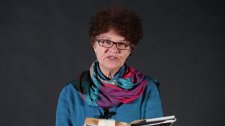
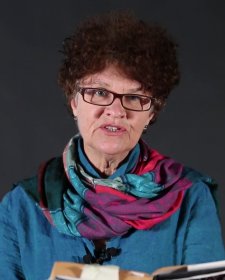
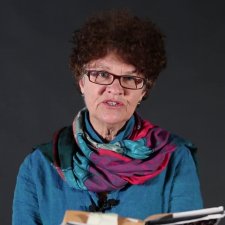
Kate Grenville reads a passage from her novel The secret river and describes its creation.
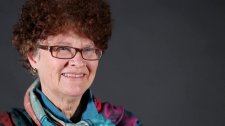
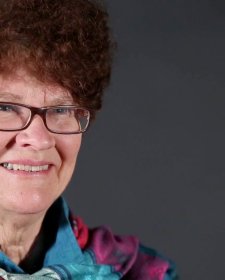
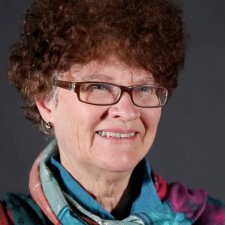
Australian writer Kate Grenville discusses her career and portrait by Jenny Sages.